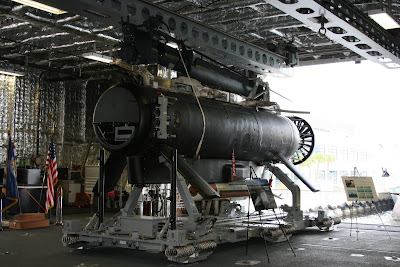Navy Looks to Small Business to Solve RMS Problems
Lockheed Martin's troubled AN/WLD-1 Remote Minehunting System is the key component of the U.S. Navy's Littoral Combat Ship Mine Counter-measures Mission Package (MCM MP) and has been under development for nearly two decades. The heart of the system is a diesel-powered, semi-submersible Remote Multi-Mission Vehicle (RMMV) designed to tow a variable depth mine-hunting sonar.
Testing on RMS prototypes began in 1994, but the system has yet to mature to full operational status. In an effort to work some of the kinks out of RMS, the Navy's Program Executive Officer for Littoral Combat Ships (PEO LCS) has sought the assistance of industry via the most recent Small Business Innovation Research (SBIR) program solicitation.
 |
| AN/WLD-1 aboard USS Freedom (LCS-2) |
A solicitation released by the Remote Minehunting System Program Office (PMS 403) entitled "Anticorrosion Solution for Remote Minehunting System (RMS) Tow Cable" seeks to correct early-life saltwater corrosion problems on the stainless steel tow cable used to tow the AQS-20A mine-hunting sonar from the RMMV.
PMS 403 has also requested proposals for "Semi-Autonomous, Reliable, Safe Recovery of the Remote Multi-Mission Vehicle (RMMV) in Various Sea States." The objective of this effort is to "develop technology for an autonomous, reliable, and safe system for Littoral Combat Ship INDEPENDENCE Variant to recover the RMMV in various sea states." Currently, recovery of the RMMV from the INDEPENDENCE class requires two operators. Testing has demonstrated that the the RMMV's roll can cause a misalignment of the vehicle to the capture mechanism, and damage the RMMV and handling equipment. The solicitation desires to automate portions of the recovery process to lesson the impacts of delayed human operator response time.
A final solicitation from the LCS Mission Modules Program Office, "Anti-Jamming Capability for RT-1944/U Radio," seeks to retrofit anti-jamming capability on the radio that allows LCS to communicate over line of sight distances with the RMMV and the Unmanned Influence Sweep unmanned surface vehicles that are also part of the LCS' MCM MP.
A final solicitation from the LCS Mission Modules Program Office, "Anti-Jamming Capability for RT-1944/U Radio," seeks to retrofit anti-jamming capability on the radio that allows LCS to communicate over line of sight distances with the RMMV and the Unmanned Influence Sweep unmanned surface vehicles that are also part of the LCS' MCM MP.
SBIR is a competitive program that encourages domestic small businesses to engage in federal research and development with the potential for commercialization. These SBIR solicitations close on January 16, 2013.

It has been three months since the SBIR Solicitations closed. Any solution(s)? What is the status of WLD-1 in an operational sense? For example, has it been able to demonstrate operational capability and reliability in its intended mission set?
ReplyDeleteInterested to see how it compares to the DORADO RMS.